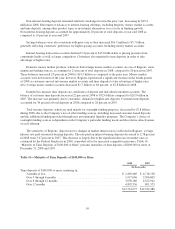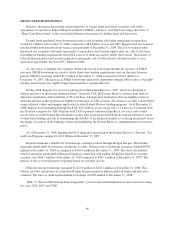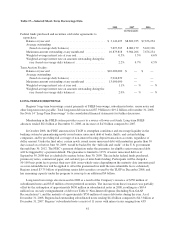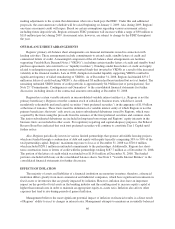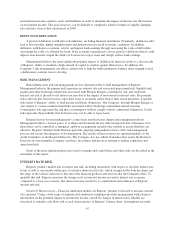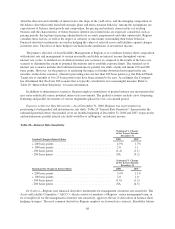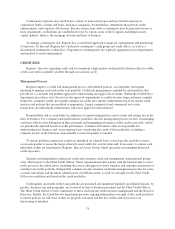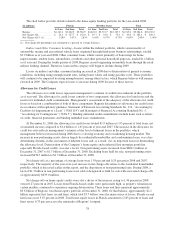Regions Bank 2008 Annual Report Download - page 79
Download and view the complete annual report
Please find page 79 of the 2008 Regions Bank annual report below. You can navigate through the pages in the report by either clicking on the pages listed below, or by using the keyword search tool below to find specific information within the annual report.contracts, interest rate swaps, options on interest rate swaps, interest rate caps and floors, and forward sale
commitments. Derivatives are also used to hedge the risks associated with customer derivatives, which include
interest rate, credit and foreign exchange risks.
Forward rate contracts are commitments to buy or sell financial instruments at a future date at a specified
price or yield. A Eurodollar futures contract is a future on a three-month Eurodollar deposit. Eurodollar futures
contracts subject Regions to market risk associated with changes in interest rates. Because futures contracts are
cash settled daily, there is minimal credit risk associated with Eurodollar futures. Interest rate swaps are
contractual agreements typically entered into to exchange fixed for variable (or vice versa) streams of interest
payments. The notional principal is not exchanged but is used as a reference for the size of interest settlements.
Interest rate options are contracts that allow the buyer to purchase or sell a financial instrument at a
predetermined price and time. Forward sale commitments are contractual obligations to sell market instruments
at a future date for an already agreed-upon price. Foreign currency contracts involve the exchange of one
currency for another on a specified date and at a specified rate. These contracts are executed on behalf of the
Company’s customers and are used to manage fluctuations in foreign exchange rates. The Company is subject to
the credit risk that another party will fail to perform.
Regions has made use of interest rate swaps to effectively convert a portion of its fixed-rate funding position
to a variable-rate position and, in some cases, to effectively convert a portion of its variable-rate loan portfolio to
fixed-rate. Regions also uses derivatives to manage interest rate and pricing risk associated with its mortgage
origination business. In the period of time that elapses between the origination and sale of mortgage loans,
changes in interest rates have the potential to cause a decline in the value of the loans in this held-for-sale
portfolio. Futures contracts and forward sale commitments are used to protect the value of the loan pipeline and
loans held for sale from changes in interest rates and pricing.
Regions manages the credit risk of these instruments in much the same way as it manages credit risk of the
loan portfolio by establishing credit limits for each counterparty and through collateral agreements for dealer
transactions. For non-dealer transactions, the need for collateral is evaluated on an individual transaction basis
and is primarily dependent on the financial strength of the counterparty. Credit risk is also reduced significantly
by entering into legally enforceable master netting agreements. When there is more than one transaction with a
counterparty and there is a legally enforceable master netting agreement in place, the exposure represents the net
of the gain and loss positions with and collateral received from and/or posted to that counterparty. The “Credit
Risk” section in this report contains more information on the management of credit risk.
Regions also uses derivatives to meet the needs of its customers. Interest rate swaps, interest rate options
and foreign exchange forwards are the most common derivatives sold to customers. Other derivatives
instruments with similar characteristics are used to hedge the market risk and minimize volatility associated with
this portfolio. Instruments used to service customers are held in the trading account, with changes in value
recorded in the consolidated statements of operations.
The primary objective of Regions’ hedging strategies is to mitigate the impact of interest rate changes, from
an economic perspective, on net interest income and the net present value of its balance sheet. The overall
effectiveness of these hedging strategies is subject to market conditions, the quality of Regions’ execution, the
accuracy of its valuation assumptions, counterparty credit risk and changes in interest rates. As a result, Regions’
hedging strategies may be ineffective in mitigating the impact of interest rate changes on its earnings. See Note
22 “Derivative Financial Instruments and Hedging Activities” to the consolidated financial statements for a
tabular summary of Regions’ year-end derivatives positions.
On January 1, 2009 Regions made an election allowed by FAS 156 and began accounting for mortgage
servicing rights at fair market value with any changes to fair value being recorded within mortgage income. Also,
in early 2009, Regions entered into derivative transactions to mitigate the impact of market value fluctuations
related to mortgage servicing rights.
69


